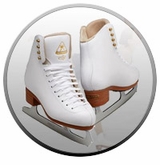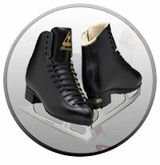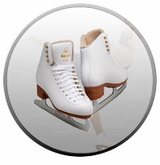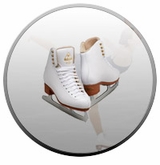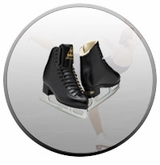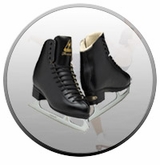Figure Skating Jumps
Figure skating jumps are identified by the take-offs and the number of rotations in the air. The two common types of figure skating jumps are edge jumps and toe jumps. Edge jumps are figure skating jumps that originate from the edge of the figure skate’s blade. Let’s talk about edge jumps first, by examining the figure skate’s blade edges for a better understanding.
Edge Jumps : Ice skate blades have two edges, the inside and the outside. To perform figure skating jumps, you will need to know whether to take off on the right (foot) forward (direction of the skater) inside or outside edge (of the blade). As you read about figure skating jumps, you will often see abbreviations like “right forward inside” (RFI) in reference to directions for specific figure skating jumps.
Toe Jumps : Toe jumps are figure skating jumps that utilize the toe pick of the ice skate to catapult the figure skater into the air. Almost all toe jumps are edge jumps with a toe assist by the opposite foot on take-off.
The overall body position is very important when performing figure skating jumps. If the skater does not maintain the proper body position, he or she will be more likely to fall or improperly execute the figure skating jump. The body position for most figure skating jumps are pretty much the same once airborne. For most figure skating jumps, the skater will have his or her legs crossed with the feet together, and the arms across the chest.
Some of the basic figure skating jumps are as follows: The Bunny Hop jump, the Waltz jump, the Loop jump, the Walley jump, the Lutz jump, the Salchow jump, the Flip jump, and the Axel jump. See below for more information for each of these figure skating jumps.
Figure Skating Bunny Hop Jump
The bunny hop jump does not require the body to rotate, and is performed in a straight line. Therefore, the bunny hop jump is probably the easiest figure skating jump for a beginning figure skater to learn and perfect. The bunny hop jump takes off from the left foot and lands on the right skate toe pick, and the left foot. Please see the steps below to perform the Bunny Hop jump.
1. Begin skating in a straight line. 2. Place body weight on the right foot. 3. The left arm is in front, right arm to the side. 4. The body should be in a position of perfect posture. 5. To prepare for the take off, step onto the left foot. 6. The arms are moving in a natural walking motion. 7. Bend the left knee and extend the right leg back. 8. Bring the right leg in front and move the arms in a quicker walking motion. 9. Slightly lean forward and spring from the left leg. 10. Prepare to hit the ice with the right toe pick. 11. At the moment the right toe pick hits the ice, place the left foot on the ice and push off with the right skate.
Waltz Jump
The waltz jump consists of a take off from a forward outside edge; a half revolution jump, and landing on the opposite back outside edge. The waltz jump is normally one of the first figure skating jumps skaters learn to perform. Please see the steps below to perform the waltz jump.
1. Begin skating backward crossovers to gain some speed. 2. Step onto the left foot; right leg behind and the arms straight out to the side. 2. Bend and extend the legs in preparation for the jump. 3. Swing the arms and free leg forward and lift off from the left toe pick. 4. Once in the air, keep your arms spread out to the side, legs remain in the open position and perform a half revolution. 5. Land on a right back outside edge.
Loop Jump
Loop Jump Origin: Precisely who invented the loop jump is uncertain. Some give credit to Werner Rittberger, a German figure skater who is said to have invented the loop jump in 1910. Werner Rittberger was an outstanding figure skater who won the German Nationals Championship 11 times between 1911 and 1928.
The loop jump starts on a right back outside edge. The loop consists of one revolution and ends with a landing on a right back outside edge. Please see the steps below to perform the toe loop figure skating jump.
1. Begin skating on a left back inside edge and position the arms out to the side. 2. Shift the weight to the right foot, and place the feet at a 45-degree angle, mirroring each other. 3. Lift-off from a right back outside edge (arms down and forward). 4. Bring the arms into the chest and legs crossed; perform one revolution. 5. Land on a right back outside edge.
There are multiple variations to the loop jump. There is the double loop jump, the triple and quadruple loop jump, and the half loop figure skating jump.
Toe Loop Jump
Toe Loop Jump Origin: The toe loop jump was invented by an American figure skater, Bruce Mapes, sometime in the 1920s while skating as an amateur; Bruce Mapes later became a professional ice skater in the 1930s.
The toe loop jump starts on a right back outside edge and uses a left toe assist to leap into the air. The toe loop jump consists of one revolution and ends with a landing on a right back outside. Please see the steps below to perform the toe loop figure skating jump.
1. Begin skating on a left forward inside edge. 2. The arms should be positioned with the right arm and shoulder back, and the left arm and shoulder forward. 3. Next step onto a right forward inside edge and rotate counterclockwise into a three-turn. 4. After the three-turn, reach back with the left leg. 5. As the jump begins, rotate the shoulders counterclockwise, parallel to the skating foot; use a left toe assist. 6. Bring the arms into the chest and perform one revolution. 7. Land on a right back outside edge.
There are multiple variations to the toe loop jump. There is the double toe loop jump, the triple and quadruple toe loop figure skating jump.
Walley Jump
Walley Jump Origin: Precisely who invented the Wally jump is somewhat controversial. The Walley jump was first performed by Pat Low from England, but named after Nathan Wally who first performed the Walley jump in the United States. Some argue that Pat Low invented the jump, while others claim that it was Nathan Wally.
The Walley jump is an edge jump that takes off from the right back inside edge, and makes one counterclockwise revolution in the air; landing on a right back outside edge of the same foot as was used for the take-off. Please see the steps below to perform the Walley figure skating jump.
1. Begin skating and perform a counterclockwise inside Mohawk. 2. Step on the right back inside edge. 3. Swing the right arm and shoulder back with the left arm in front. 4. Left leg should be bent and behind, right leg deeply bent. 5. Begin the jump by lifting the left leg to the side. 6. Rotate the arms and shoulders counterclockwise for the take-off. 7. The lift off is in progress; contract the arms in a rotating position; legs should be close together and side by side. 8. Make one revolution and land on a right back outside edge.
Toe Walley Jump
We have listed steps below that explain the steps used for a single toe Walley figure skating jump. To perform a double or triple toe Walley jumps, follow these same steps, but add the appropriate number of revolutions during the jump.
1. Begin skating with left arm and shoulder forward. 2. Perform a left forward outside three-turn. 3. Rotate the arms clockwise to build momentum for the lift-off. 4. When the shoulders are in line with the skating foot, place the left toe pick on the ice and spring from the right leg (look over the left shoulder). 5. During the jump, cross the legs and arms across the chest. 6. Perform one revolution and land on the right back outside edge.
Lutz Jump
Lutz Jump Origin: The Lutz jump was invented by Alois Lutz of Austria. He first performed the Lutz jump during a figure skating competition in 1913.
The Lutz jump begins with the figure skater skating backwards. The take off is from a left back outside edge with a right toe pick assist. The figure skater will make one counterclockwise revolution and land on a right back outside edge. The Lutz jump is considered to be one of the most difficult one revolution figure skating jumps. Please see the steps below to perform the Lutz figure skating jump.
1. Skate back crossovers clockwise and step onto a left back outside edge. 2. Look over the right shoulder; relax the arms. 3. The right arm and leg reaches back to prepare for the jump. 4. Place the right toe pick on the ice and spring from the left leg. 5. The left arm and shoulder will assume the forward position. 6. Perform two counterclockwise revolutions with the arms across the chest and the legs crossed. 7. The landing is on a right back outside edge.
Salchow Jump
Salchow Origin: The Salchow jump was invented by Ulrich Salchow of Sweden in 1909. Ulrich Salchow was considered to be an outstanding figure skater and held the World Championship title 10 different times between 1900 and 1911.
The Salchow jump is an edge figure skating jump that takes off from a back inside edge, makes one revolution and lands on a right back outside edge. The Salchow jump is considered one of the easiest single revolution figure skating jumps. Please see the steps below to perform the Salchow jump.
1. To begin the Salchow jump, the figure skater will be skating backward crossovers. 2. Rotate counterclockwise into a left forward outside three-turn. 3. Begin the Salchow jump by springing from the left foot. 4. Make one revolution and land on a right back outside edge.
There are multiple variations to the Salchow jump. There is the double Salchow jump, the triple and quadruple Salchow jump, and the delayed Salchow figure skating jump.
Flip Jump
Flip Jump Origin: The flip jump is believed by many to have been invented by an American figure skater, Bruce Mapes, sometime in the 1920s while skating as an amateur; Bruce Mapes later became a professional ice skater sometime in the 1930s.
The flip jump is performed with the figure skater, skating backwards. The flip jump takes off from a left back inside edge, with a right toe assist. It has one counterclockwise revolution during the jump, landing on a right back outside edge. Please see the steps below to perform the flip figure skating jump.
1. Begin skating and skate a left forward inside edge. 2. The left arm and shoulder should be toward the front with the right arm and shoulder toward the back. 3. Change edges and rotate the arms and shoulders counterclockwise. 4. Rotate for a three-turn, then check the three-turn by twisting backwards with the right arm and shoulder. 5. Following the three-turn, extend right leg behind and bend the left knee. 6. Plant the right toe pick to initiate the lift-off. 7. During the lift, change arm and shoulder positions and turn the head to the left. 8. During the jump, cross the arms over the chest and cross the legs. 9. Perform one revolution and land on a right back outside edge.
There are two variations to the flip jump. There is the double flip jump and the triple flip figure skating jump; the differences are related to the number of revolutions in the air.
Axel Jump
Axel Jump Origin: The Axel Jump was invented by Axel Paulsen of Norway. He performed the Axel jump during one of the first known international competitions in Vienna, Austria in 1882.
The Axel jump is an edge figure skating jump that takes off from a forward outside edge, makes one and a half revolutions, and lands on the back outside edge of the opposite foot. The Axel jump is considered to be one of the most difficult figure skating jumps to master. Please see the steps below to perform the Axel figure skating jump.
1. To begin the Axel jump, skate on a right back outside edge. 2. Bring the left leg back to the right skate with the left shoulder and hip checked (look over the left shoulder). 3. Step on the left outside edge with the left shoulder leading and the right arm and right leg toward the back. 4. The lift off is in progress - the right arm and right leg are pushed forward and up to increase the height and rotation. 5. Perform one and a half revolutions; during last part of the single revolution, bring the arms across the chest and cross the legs. 6. Look forward and check hard as you land on the ice.
There are multiple variations to the Axel figure skating jump. There is the double Axel jump, the triple Axel jump, the delayed Axel jump and the Russian Split Axel jump. The differences of all of these variations are either related to the number of rotations, or to the body position in the air.
Figure Skating Jumps: Safety
Figure skating jumps are exhilarating to perform and exciting to watch, but figure skating jumps are inherently dangerous. Therefore, time and effort should be applied to learning the proper techniques and potential risks associated with figure skating jumps. Finally, we encourage everyone to seek professional instruction, and wear proper protective equipment when learning how to perform figure skating jumps.
|
Skate Equipment >
Ice Skating Equip
Ice Skating Info
.
